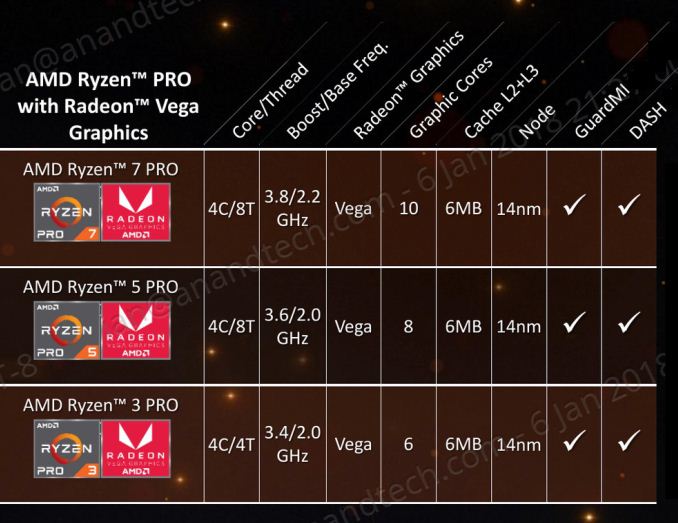AMD Tech Day at CES: 2018 Roadmap Revealed, with Ryzen APUs, Zen+ on 12nm, Vega on 7nm
by Ian Cutress on February 1, 2018 8:45 AM ESTZen and Vega: Ryzen PRO Mobile
In the second half of last year, AMD’s Enterprise, Embedded and Semi-Custom division (now the Enterprise and Embedded division) launched its Ryzen PRO family of desktop processors, for business customers that needed additional management capabilities. AMD has been making ‘Pro’ versions of its consumer processors for several generations now, usually mimicking the specifications of the consumer products aside from the management support.
These products, by and large, go up against Intel’s equivalent vPro processors, and AMD’s value add revolves around support for DASH, an open-source management protocol, TSME (transparent secure memory encryption), and its commitment to customer requests such as operating system image stability (18-months), guaranteed processor availability (24-months), manufacturing specifications designed for long-term reliability, and a commercial limited warranty (36-months). AMD also likes to tout that it offers a Pro product at the lower end of the market, where Intel does not have a vPro-enabled Core i3.
As part of the AMD Tech Day, it was announced that the Ryzen PRO Mobile family will be launched in Spring 2018. These components are, by and large, the Ryzen Mobile family of processors with Vega graphics but with the added Pro features listed above. For performance and power, AMD states similar sorts of numbers as it did with the launch of Ryzen Mobile: up to 270% better performance per watt, targeting 13 hours of useful battery life, 9 hours of HD video playback, and targeting a generation of sleek and powerful laptops, in this case focused for the Enterprise market.
So much like the Ryzen 7 2700U, the Ryzen 5 2500U, and the Ryzen 3 2300U, AMD will launch the Ryzen PRO Mobile equivalents:
We are likely to see OEMs that currently provide AMD A-Series PRO notebooks to offer updated versions with these new processors, as well as a series of new designs coming into the business and enterprise market.











131 Comments
View All Comments
iwod - Monday, January 8, 2018 - link
Does Vega 7nm necessarily means GF though? I thought the drop of Vega 12nm+ make sense as it would be competing with Ryzen for GF capacity. Given how AMD is doing well and should be even better now when Meltdown is on Intel.I would have thought moving Radeon back to TSMC would be a much better choice.
Outlander_04 - Tuesday, January 9, 2018 - link
TSMC ? Why?It would also mean higher costs for AMD
Holliday75 - Tuesday, January 9, 2018 - link
Just a guess, but based off his comment he suggested that Radeon would be competing for fab space at GF. If reduced capacity for Zen cuts into profits then the extra costs to move might be worth it.Just basing this off of his comment.
Stuka87 - Monday, January 8, 2018 - link
I sure hope Dell comes out with a Precision laptop with AMD stuff. The Inspirons share a lot with the Precisions.Dragonstongue - Monday, January 8, 2018 - link
so it sounds like a "refresh" to RX 500 series which was claimed for 2018 is not happening, that sucks TBH..need a new GPU and many of the "good" RX 570-580s are out of stock or low in stock ballooning their prices, need replace my 7870 sometime soon, 460/560 will not cut it, and spending ~$80 more than should is a no go for me to replace it. 1280 shader 256 bit bus with a bump in ROP/TMU at 170w maximum (heavily overclocked) 7870 was THE "mainstream" performance card for its generation, have not seen AMD nor Nv release one that is "comparable" either higher performance (higher price) or less performance (similar price) but nothing to supplant it really.
Good news though, just shows that Zen+ (12nm) is/was not Zen2 (was always to be on 7nm) which I told off many a 3rd party "review" site claiming it would be ^.^
Sttm - Monday, January 8, 2018 - link
The GPU roadmap is so sad. AMD barely has a GPU that can top the GTX1080 I bought Summer 2016, and won't have a truly superior offering until 2019.My only hope of a proper upgrade is now Volta, and Nvidia will have no reason not to price gouge with this pathetic competition!
Arbie - Monday, January 8, 2018 - link
@Sttm - I'm also sorry that AMD's graphics wasn't a win in 2017. But I wonder what games you could possibly find good enough to warrant moving "up" from a 1080? The tiny increase in quality or FPS would only be meaningful - maybe - on a game you love that has top-notch graphics AND doesn't look good enough on your current card. I only wish there was something even close to that for me.gerz1219 - Thursday, February 1, 2018 - link
Plenty of modern games play somewhat smoothly at 4K on a 1080 Ti, but could use a bump up in fps. Once you see 4k gaming, it's kind of hard to unsee, which is why I haven't bothered to buy a 1440p gaming panel to complement my professional panel. I'd gladly pay another $700 + the cost of a 4K Gsync/Freesync monitor next year to upgrade the 1080 Ti to something that can crush any game at 4K, but it doesn't look like that product will hit the market in 2019 because AMD is so far behind, and everyone's making tons of money selling GPUs for crypto.sld - Monday, January 8, 2018 - link
Those who buy price gouging items walk into it willingly. Gsync vs Freesync, for example.Santoval - Monday, January 8, 2018 - link
I hope you'll get better soon Ian. I don't think I would be able to type a single sentence if I were in your shoes, I have to admit am impressed by your resilience.